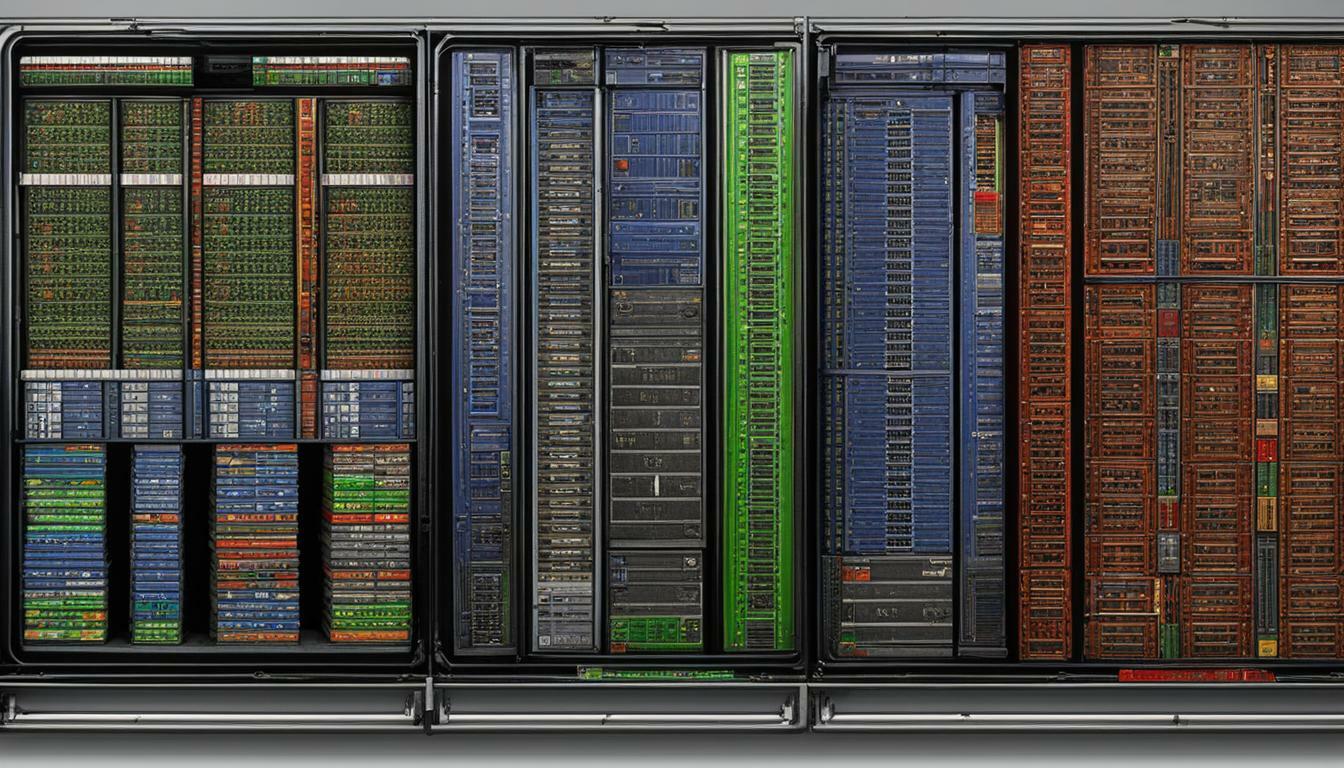Are you familiar with the key differences between REST and GraphQL API technologies? The way data is fetched from the server is the main distinction between these two technologies. In REST, multiple requests are made to different endpoints to gather the required data. This approach often results in issues like overfetching or underfetching. On the other hand, GraphQL allows the client to send a single query to the server, specifying the exact data requirements. It eliminates the problems associated with overfetching and underfetching, offering a more efficient data fetching mechanism.
Key Takeaways:
- REST uses multiple requests to different endpoints for data fetching, while GraphQL uses a single query specifying the exact data requirements.
- GraphQL offers advantages such as rapid prototyping, fine-grained insights into data usage, and a strong type system that defines API capabilities.
- Potential drawbacks of GraphQL include performance issues with complex queries and the need for additional tooling for error handling and file uploading.
- REST can still be a suitable option for simpler applications and projects, depending on specific requirements and goals.
Fetching Data: REST’s Multiple Requests vs GraphQL’s Single Query
Let’s delve into the contrasting approaches to data fetching in REST and GraphQL. In REST, multiple requests to different endpoints are made to gather all the required data, which can result in overfetching or underfetching. This means that additional data is retrieved, leading to wastage of resources, or insufficient data is fetched, resulting in the need for subsequent requests. It can be a cumbersome process, especially when dealing with complex data structures and relationships.
On the other hand, GraphQL offers a more streamlined approach. With GraphQL, the client sends a single query to the server, specifying the exact data requirements. This allows for precise data fetching, eliminating the issues of overfetching and underfetching commonly encountered in REST. The server responds with the requested data, ensuring that only the necessary information is retrieved. This not only improves efficiency but also reduces network overhead.
Fetching Data: REST’s Multiple Requests vs GraphQL’s Single Query
To further illustrate the key differences, let’s consider an example scenario where we want to retrieve information about a user and their associated posts. In REST, we would typically make separate requests to retrieve the user data and the post data. This could involve multiple API calls to different endpoints, each returning a specific subset of the required data.
In contrast, with GraphQL, we can send a single query that specifies the fields we need from both the user and post objects. The server then responds with a JSON object that contains all the requested data, avoiding the need for multiple requests. It simplifies the data fetching process and reduces the amount of data transferred over the network.
| REST | GraphQL |
|---|---|
| Requires multiple requests | Single query |
| Potential overfetching or underfetching | Precise data fetching |
| Complex data retrieval | Simplified data fetching |
In summary, the key difference between REST and GraphQL lies in the approach to data fetching. REST involves making multiple requests to different endpoints, potentially leading to overfetching or underfetching. On the other hand, GraphQL allows for a more efficient and precise data retrieval process through a single query. The choice between REST and GraphQL depends on the specific requirements and complexity of the project. While GraphQL offers advantages in terms of flexibility and efficiency, REST can still be a viable option for simpler applications and projects.
Benefits of GraphQL: Rapid Prototyping and Fine-Grained Insights
Discover the advantages that GraphQL brings to the table, including rapid prototyping and fine-grained insights into data usage. With GraphQL, developers can quickly iterate and experiment with their queries, allowing for rapid prototyping and efficient development. By specifying the exact data requirements in a single query, GraphQL eliminates the need for multiple requests to different endpoints, reducing network overhead and enhancing performance.
One of the key benefits of GraphQL is its fine-grained insights into data usage. GraphQL provides detailed information on how data is being accessed, allowing developers to optimize their queries and ensure efficient data fetching. This level of visibility into data usage can be particularly beneficial for large-scale applications with complex data requirements.
GraphQL’s strong type system also plays a significant role in its benefits. It defines the API capabilities and provides clear documentation for the available data and operations. This helps to reduce ambiguity and improve communication between the front-end and back-end teams, leading to faster development cycles and better collaboration.
Demonstrating the Benefits
To illustrate the advantages of GraphQL, let’s consider an example scenario. Suppose we have an e-commerce application that needs to retrieve product information, including the name, price, and customer reviews. In a RESTful API, this would typically require multiple requests to different endpoints, resulting in overfetching or underfetching of data.
| REST API | GraphQL API |
|---|---|
|
|
As shown in the table, with GraphQL, a single query can fetch all the required data in one go, providing a more efficient and streamlined approach. This not only reduces network round trips but also allows for better control over data fetching, ensuring that only the necessary data is retrieved.
In summary, GraphQL offers rapid prototyping capabilities, fine-grained insights into data usage, and a strong type system that enhances development efficiency. However, it’s important to consider potential performance issues with complex queries and the need for additional tooling when comparing the pros and cons of REST and GraphQL. Ultimately, the choice between the two depends on the specific requirements and goals of the project.
Drawbacks of GraphQL: Performance and Tooling Challenges
Despite its benefits, GraphQL is not without its drawbacks. One potential challenge is related to performance. When handling complex queries in GraphQL, a large amount of data may need to be processed, which can potentially slow down the system. It is crucial for developers to carefully optimize their queries and implement efficient caching strategies to mitigate performance issues.
Another challenge with GraphQL is the need for additional tooling compared to REST. While REST has well-established tools and frameworks, GraphQL is relatively newer and may require developers to explore and adopt new tools specifically designed for GraphQL. For example, error handling and tasks like file uploading may require additional libraries or custom implementations.
Despite these challenges, GraphQL’s flexibility and efficiency make it a compelling option for many developers and organizations. By addressing the potential performance issues and investing in appropriate tooling, GraphQL can offer significant benefits in terms of rapid prototyping, fine-grained insights into data usage, and scalability.
In summary, GraphQL offers a powerful alternative to REST API technologies. While it introduces new challenges in terms of performance optimization and tooling, these drawbacks can be overcome with careful planning and implementation. Ultimately, the choice between REST and GraphQL depends on the specific requirements and goals of the project, with GraphQL being particularly well-suited for data-intensive and complex applications.
| Pros of GraphQL | Cons of GraphQL |
|---|---|
| Rapid prototyping | Potential performance issues |
| Fine-grained insights into data usage | Additional tooling requirements |
| Strong type system |
REST as a Viable Option for Simpler Applications
Is GraphQL always the better choice? Find out why REST still has its place in simpler applications.
While GraphQL has gained popularity for its flexibility and efficiency in handling complex and data-intensive applications, REST continues to be a viable option for simpler projects. REST’s simplicity and straightforwardness make it a great choice when the data requirements are relatively straightforward, and there is no need for complex querying.
One of the advantages of REST is its ease of implementation. With REST, developers can quickly set up endpoints that correspond to specific resources or data entities. This simplicity makes REST a good fit for projects with clear data structures and well-defined API endpoints.
Additionally, REST’s multiple request approach can be advantageous in simpler applications. By making separate requests to different endpoints, REST allows for better organization and separation of concerns. It enables developers to build APIs with a clear separation of responsibilities, making the codebase easier to maintain and understand.
| Advantages of REST in Simpler Applications |
|---|
| Easy implementation |
| Clear separation of concerns |
| Scalability |
Furthermore, REST’s inherent scalability can also be beneficial for simpler applications. By making use of the HTTP protocol and its caching mechanisms, REST APIs can efficiently handle large numbers of requests, making it suitable for applications with lower traffic volumes.
While GraphQL offers advantages in terms of fine-grained data fetching and rapid prototyping, REST’s simplicity, ease of implementation, clear separation of concerns, and scalability make it a valid choice for simpler applications. When deciding between REST and GraphQL, it is important to consider the specific requirements and goals of the project, as well as the complexity of the data and querying needs.
Conclusion
In conclusion, understanding the differences between REST and GraphQL API technologies is crucial for developers seeking the most suitable approach for their projects. While REST and GraphQL both have their advantages and drawbacks, they offer distinct ways of fetching data from the server.
REST, with its multiple requests to different endpoints, can lead to issues like overfetching or underfetching. On the other hand, GraphQL allows clients to send a single query to the server, eliminating these problems and providing a more efficient way of obtaining specific data requirements.
GraphQL offers additional benefits, such as rapid prototyping, allowing developers to easily iterate and experiment with their queries. Its fine-grained insights into data usage enable efficient data fetching. The strong type system of GraphQL also defines the API capabilities, providing clarity and ease of use for developers.
However, it’s important to consider the potential drawbacks of using GraphQL. Complex queries can pose performance challenges, as large amounts of data may need to be processed. Tasks like error handling and file uploading may also require additional tooling compared to REST.
While GraphQL excels in complex and data-intensive applications, REST still remains a viable option for simpler projects. The choice between REST and GraphQL ultimately depends on the specific requirements and goals of each individual project. By understanding the strengths and weaknesses of both technologies, developers can make informed decisions to create efficient and effective APIs.
FAQ
What is the main difference between REST and GraphQL API technologies?
The main difference is the way data is fetched from the server. REST requires multiple requests to different endpoints, while GraphQL allows the client to send a single query to specify the exact data requirements.
What is overfetching and underfetching?
Overfetching occurs in REST when more data than necessary is retrieved, leading to wasted resources. Underfetching happens when data is missing, requiring additional requests. GraphQL eliminates these issues by allowing precise data requests.
What benefits does GraphQL offer?
GraphQL provides rapid prototyping capabilities, allowing developers to iterate and experiment with queries. It also offers fine-grained insights into data usage and a strong type system defining API capabilities.
What are the drawbacks of using GraphQL?
Complex queries in GraphQL can result in performance issues, especially when handling large amounts of data. Additionally, tasks like error handling and file uploading may require additional tooling compared to REST.
Is REST still a viable option for simpler applications?
Yes, while GraphQL excels in complex and data-intensive applications, REST can still be a suitable choice for simpler projects depending on their specific requirements and goals.

